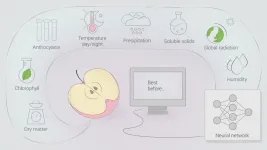Study: Insights from two reopened schools during the COVID-19 pandemic
2021-03-30
(Press-News.org) Since early in the COVID-19 pandemic, parents, teachers, and school administrators have faced difficult questions regarding when and how to safely reopen for in-person learning. During the 2020-2021 fall semester, school districts around the United States navigated their reopening plans -- many opting for exclusively online learning or hybrid models -- with little data on how SARS-CoV-2 spreads among children or how in-person learning would impact transmission in the schools' communities. A new study in The Journal of School Health joins a growing body of evidence that, with appropriate measures, there are ways for schools to safely reopen.
In this study, scientists analyzed data from two large, independent k-12 schools that re-opened for in-person learning last fall. The results suggest that, with robust universal testing and mitigation measures, in-school transmission can remain low even as the surrounding community transmission rates rise.
The two schools in this study, one located in the southeastern United States and the other in the Mid-Atlantic, both conducted regular testing of all students and staff and required mitigation measures like mask-wearing, social distancing, and ventilation and air filtering. When positive cases were detected, the schools and local health authorities did contact tracing to determine how the person was likely exposed.
Throughout the semester, both schools saw cases, but the rate of transmission was 0.5 or lower. "Because each infection causes less than one additional infection on average, an infection doesn't spread much within the school," says Santa Fe Institute Professor Michael Lachmann, who co-authored the study with Santa Fe Institute External Professor Lauren Ancel Meyers (University of Texas at Austin), Darria Long Gillespie, Stephen C Redd, and Jonathan M Zenilman. "If we could get a rate of 0.5 in the community, that would be amazing -- we would be rid of COVID already."
In addition, neither school observed any instance where a teacher was infected by a student or vice versa. While in-school transmission did occur, 72% of those cases in one school were associated with non-mask-wearing. No outbreaks at either school occurred from in-school transmission when mitigation measures were being followed. However, testing revealed a spike in cases at the start of the school year and following fall break -- times when the students were out of school -- and one school had an outbreak following an out-of-school football party.
So, is it safe to reopen schools, and to do so before all teachers are vaccinated?
"While that depends on your definition of 'safe,' this study says that if you implement all these measures, including testing, there won't be big outbreaks in schools," says Lachmann. "But the key here is testing. If you implement all these measures, testing allows you to see when things go wrong."
Still, there are several caveats. The new, more contagious, variants will likely require schools to be extra vigilant to avoid outbreaks. Also, both schools in this study had the resources to conduct regular testing. "Given that both schools are well-resourced, with a population that likely has a lower burden of chronic disease and better access to medical care, the exact consequence of these introductions in less well-resourced communities is not known," write the authors in the study. "There is a critical need for educational and public health support of rapid expansion of school-based testing capacity and the resources required if communities are to return to in-person education."
INFORMATION:
ELSE PRESS RELEASES FROM THIS DATE:
2021-03-30
WASHINGTON--A vast global ocean may have covered early Earth during the early Archean eon, 4 to 3.2 billion years ago, a side effect of having a hotter mantle than today, according to new research.
The new findings challenge earlier assumptions that the size of the Earth's global ocean has remained constant over time and offer clues to how its size may have changed throughout geologic time, according to the study's authors.
Most of Earth's surface water exists in the oceans. But there is a second reservoir of water deep in Earth's interior, in the form of hydrogen and oxygen attached to minerals in the mantle.
A new study in AGU Advances, which publishes high-impact, open-access research and commentary across the Earth and space sciences, estimates how much water ...
2021-03-30
A researcher from Skoltech and his German colleagues have developed a neural network-based classification algorithm that can use data from an apple orchard to predict how well apples will fare in long-term storage. The paper was published in Computers and Electronics in Agriculture.
Before the fruit and vegetables we all like end up on our tables, they have to be stored for quite some time, and during this time they can develop physiological disorders such as flesh browning or superficial scald (brown or black patches on the skin of the fruit). These disorders contribute to the loss of a substantial amount ...
2021-03-30
Some 8,300 million metric tons of plastics have been manufactured since production exploded in the 1950s, with more than 75 percent ending up as waste and 15 million metric tons reaching oceans every year. Plastic waste fragments into increasingly smaller but environmentally persistent "microplastics," with potentially harmful effects on the health of people, wildlife and ecosystems. A new collection, "Confronting Plastic Pollution to Protect Environmental and Public Health," is publishing on March 30th, 2021 in the open access journal PLOS Biology that addresses critical scientific challenges in understanding the impacts of microplastics.
The collection features three evidence-based commentaries from ecotoxicology and environmental health ...
2021-03-30
RESTON, Va. - Greater sage-grouse populations have declined significantly over the last six decades, with an 80% rangewide decline since 1965 and a nearly 40% decline since 2002, according to a new report by the U.S. Geological Survey. Although the overall trend clearly shows continued population declines over the entire range of the species, rates of change do vary regionally.
The report represents the most comprehensive analysis of greater sage-grouse population trends ever produced and lays out a monitoring framework to assess those trends moving forward. The study can also be used to evaluate the effectiveness of greater sage-grouse conservation efforts and analyze factors that contribute to habitat loss and population change -- all critical ...
2021-03-30
(Philadelphia, PA) - The human heart works under high demand, constantly pumping oxygen-rich blood through the body. When faced with disease, however, fulfilling this demand can become increasingly difficult and harmful. In the case of chronic high blood pressure - a leading cardiovascular disease in the United States - the heart continuously overexerts, resulting in maladaptive growth and, ultimately, severe dysfunction of the heart muscle itself.
Maladaptive growth of the heart, known as cardiac hypertrophy, is brought about in part by activation of G protein-coupled kinase ...
2021-03-30
Researchers at Washington University in St. Louis reported the first observations of a new form of fluorine, the isotope 13F, described in the journal Physical Review Letters.
They made their discovery as part of an experiment conducted at the National Superconducting Cyclotron Laboratory at Michigan State University (MSU).
Fluorine is the most chemically reactive element on the periodic table. Only one isotope of fluorine occurs naturally, the stable isotope 19F. The new isotope, 13F, is four neutrons removed from the proton drip line, the boundary that delimits the zone beyond which atomic nuclei decay by the emission ...
2021-03-30
CAMBRIDGE, MA -- More than just a sign of illness, mucus is a critical part of our body's defenses against disease. Every day, our bodies produce more than a liter of the slippery substance, covering a surface area of more than 400 square meters to trap and disarm microbial invaders.
Mucus is made from mucins -- proteins that are decorated with sugar molecules. Many scientists are trying to create synthetic versions of mucins in hopes of replicating their beneficial traits. In a new study, researchers from MIT have now generated synthetic mucins with a polymer backbone that more accurately mimic the structure and function of naturally occurring mucins. The team also showed that these synthetic mucins could effectively neutralize the bacterial toxin that causes cholera.
The ...
2021-03-30
A study conducted at the University of Campinas (UNICAMP) in the state of São Paulo, Brazil, shows that compounds produced by gut microbiota (bacteria and other microorganisms) during fermentation of insoluble fiber from dietary plant matter do not affect the ability of the novel coronavirus SARS-CoV-2 to enter and replicate in cells lining the intestines. However, while in vitro treatment of cells with these molecules did not significantly influence local tissue infection, it reduced the expression of a gene that plays a key role in viral cell entry and a cytokine receptor that favors inflammation.
An ...
2021-03-30
HERSHEY, Pa. -- Stress, increased free time and feelings of boredom may have contributed to an increase in the number of cigarettes smoked per day during the early months of the COVID-19 pandemic by nearly a third of surveyed Pennsylvania smokers. Penn State College of Medicine researchers said understanding risk factors and developing new strategies for smoking cessation and harm reduction may help public health officials address concerning trends in tobacco use that may have developed as a result of the pandemic.
Jessica Yingst, assistant professor of public health sciences and Penn State Cancer Institute researcher, said smokers who increased the number of cigarettes they smoked per day could be at greater risk of dependence and have a more difficult ...
2021-03-30
March 30, 2021 - As cancer survival rates improve, more people are living with the aftereffects of cancer treatment. For some patients, these issues include chronic radiation-induced skin injury - which can lead to potentially severe cosmetic and functional problems.
Recent studies suggest a promising new approach in these cases, using fat grafting procedures to unleash the healing and regenerative power of the body's natural adipose stem cells (ASCs). "Preliminary evidence suggests that fat grafting can make skin feel and look healthier, restore lost soft tissue volume, and help alleviate pain and fibrosis in patients with radiation-induced skin injury ...
LAST 30 PRESS RELEASES:
[Press-News.org] Study: Insights from two reopened schools during the COVID-19 pandemic



